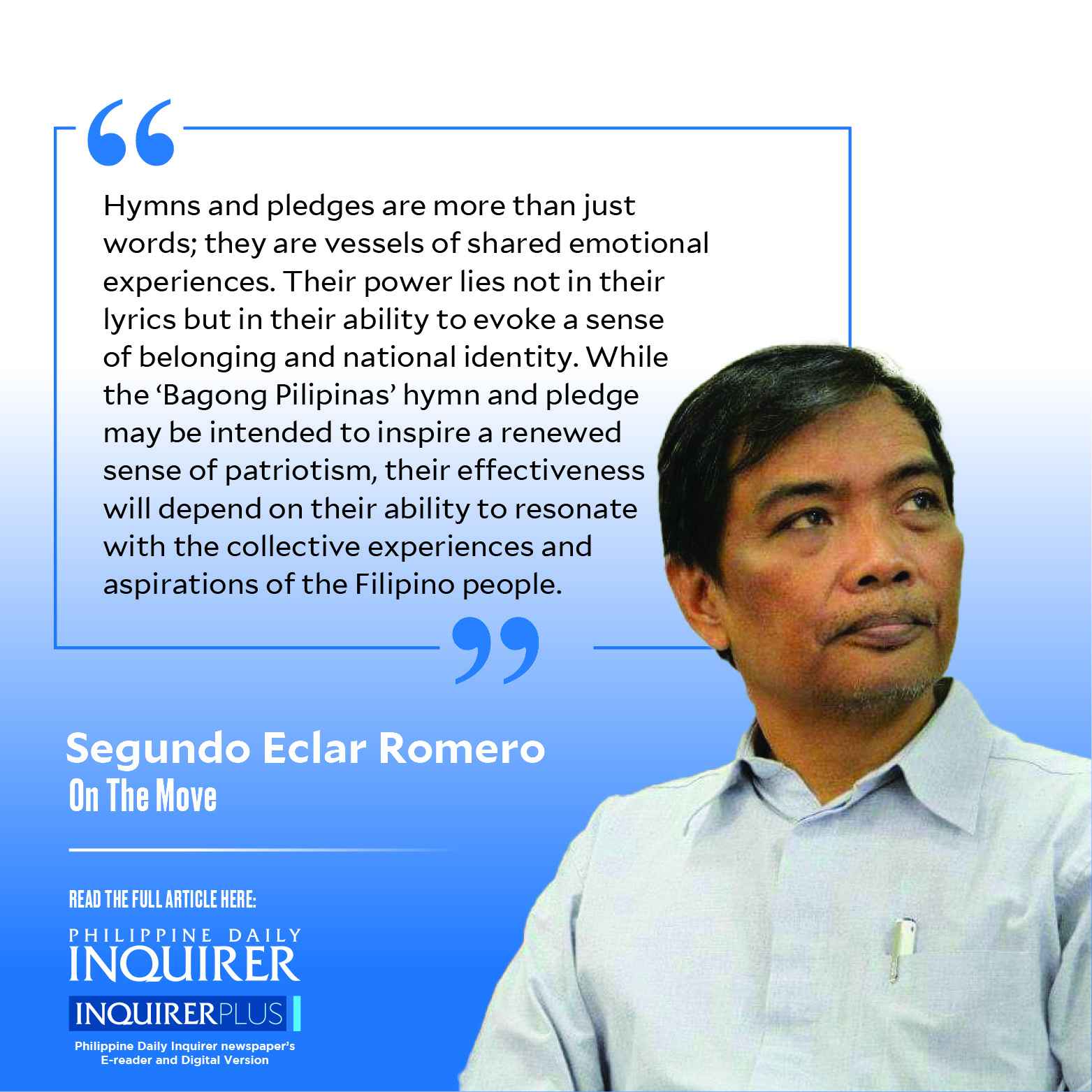Campaign jingles and national hymns
President Marcos’ recent directive to incorporate the “Bagong Pilipinas” hymn and pledge into regular flag ceremonies has sparked debate. While framed as a governance branding campaign, it appears more like a superficial attempt to signal change without addressing deeper societal issues. The lack of social preparation for the new hymn, in stark contrast to the strategic implementation of past national campaigns, including those mounted by Ferdinand Marcos Sr. under “The New Society” raises questions about its true purpose and impact.
Marcos Sr. would have decreed the song to air on radio and television every 15 minutes for a whole month before he would make the hymn mandatory. This tactic would have been a tiny element of the overall strategic campaign cobbled with the help of the combined talents of academia (especially the University of the Philippines) to craft a Filipino ideology, a Filipino reinterpretation of history, and a theoretical framework of the New Society as a “revolution from the center,” endorsed and backstopped by luminaries like Carlos P. Romulo and Onofre D. Corpuz.
Mr. Marcos gives the reassurance that “To those whose overheated imagination has been poisoned by toxic politics, Bagong Plipinas is no Trojan horse. It conceals no agenda. It is a program of many workhorses driven by the love of country.” However, this ‘Bagong Pilipinas’ hymn comes on the heels of the ‘Bagong Pilipinas’ jingle of Uniteam during the May 2022 elections, which begins with these lines:
“Bagong Pilipinas, bagong mukha; may prinsipyo, may isang salita
Oooh! Kaibigan ny’o, kaibigan n’yo, kaibigan ko
Siya si Inday Sara Duterte
Siya si Bong Bong Marcos”
—————–
Couldn’t the President have avoided this disingenuous association with their political campaign jingle? On their own, the new hymn and pledge are uninspiring, repetitive, and autologous (“iayos ang dapat ayusin,” “pagbabago tungo sa pagasenso”), so uninspiring to Filipinos who are constantly regaled with more meaningful, melodic, and engaging music.
These changes have now ignited a controversy regarding the legality and appropriateness of these actions. It also prompts a broader reflection on the role of hymns and pledges in fostering patriotism. Do they create patriotic sentiments or are they merely token expressions of distant visions of governmental and societal reforms?
Reflecting on my own experiences, the hymns and marches of my youth served as markers of shared emotional experiences. The daily flag ceremony from grade one to fourth-year high school in the 1950s and 1960s not only featured the “Lupang Hinirang” and “Panatang Makabayan.” It also featured our disciplined daily march to our classrooms to the beat of US Army and Marine marches such as “The Stars and Stripes Forever,” “Semper Fidelis,” and “The Washington Post” march. We imagined ourselves as citizen-soldiers. The artifacts of World War II were still so omnipresent along with narratives of patriotism. The American colonial period songs “Philippines, My Philippines” and “Bayan Ko,” evoked a sense of national pride and unity. These hymns were intrinsically linked to the historical context in which they emerged and their power lies in their ability to evoke memories and emotions.
Similarly, the “Bagong Lipunan” hymn of the martial law era and the “Handog ng Pilipino sa Mundo” from the 1986 Edsa People Power Revolution are deeply intertwined with the collective memories of those periods. These hymns cannot be separated from their historical contexts and repurposed without acknowledging their original evocative meanings.
What I remember as having distinctly emblematic of my political or patriotic feelings was the song “Mambo Magsaysay.” It was President Ramon Magsaysay’s campaign ditty in 1953. How eerily evocative of the national problems the song went. The jingle kept airing on radio and television ad nauseam when Magsaysay died when his plane crashed on Mount Manunggal in Cebu in March 1957. One has to be a boomer to recall the feelings of that time. The nation was crestfallen and, just seven years old, I wondered how I could cry and be as heavy-hearted as the adults around me.
Ultimately, hymns and pledges are more than just words; they are vessels of shared emotional experiences. Their power lies not in their lyrics but in their ability to evoke a sense of belonging and national identity. While the “Bagong Pilipinas” hymn and pledge may be intended to inspire a renewed sense of patriotism, their effectiveness will depend on their ability to resonate with the collective experiences and aspirations of the Filipino people. Failing that, they can be a focus of ridicule.
—————–
















